
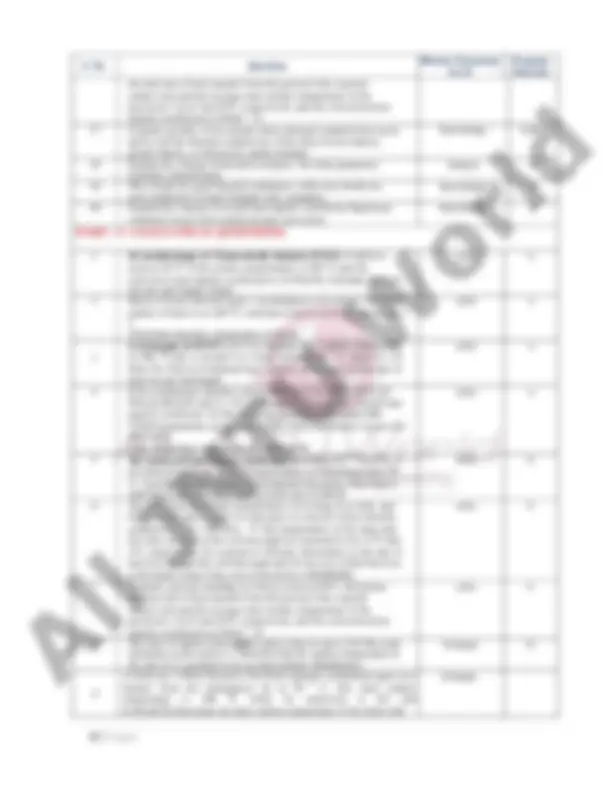
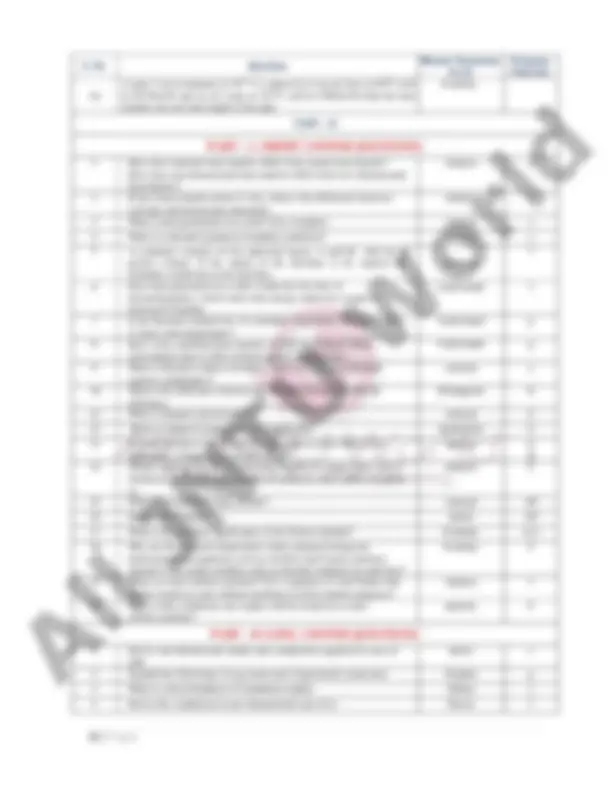
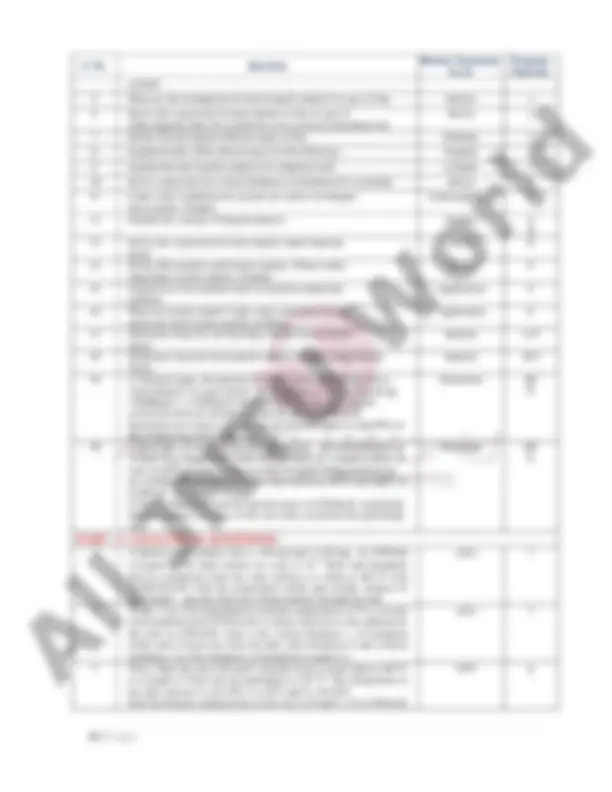
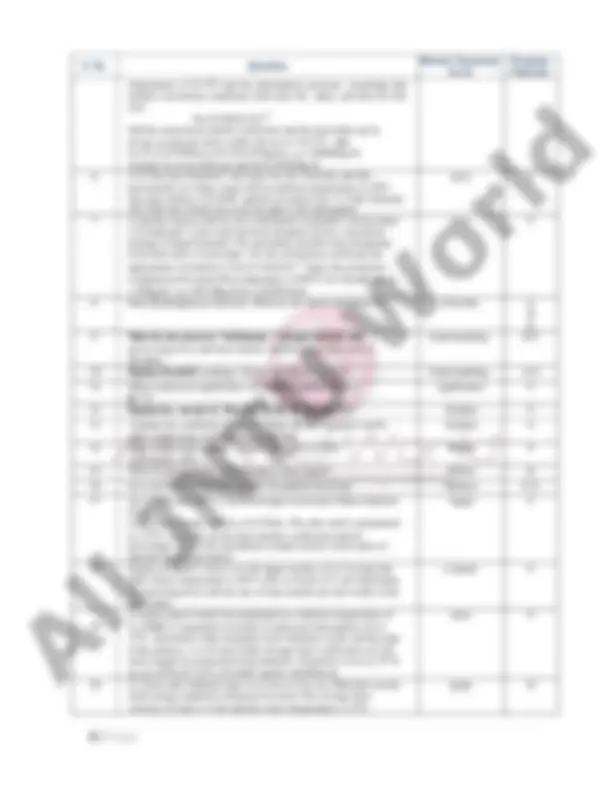
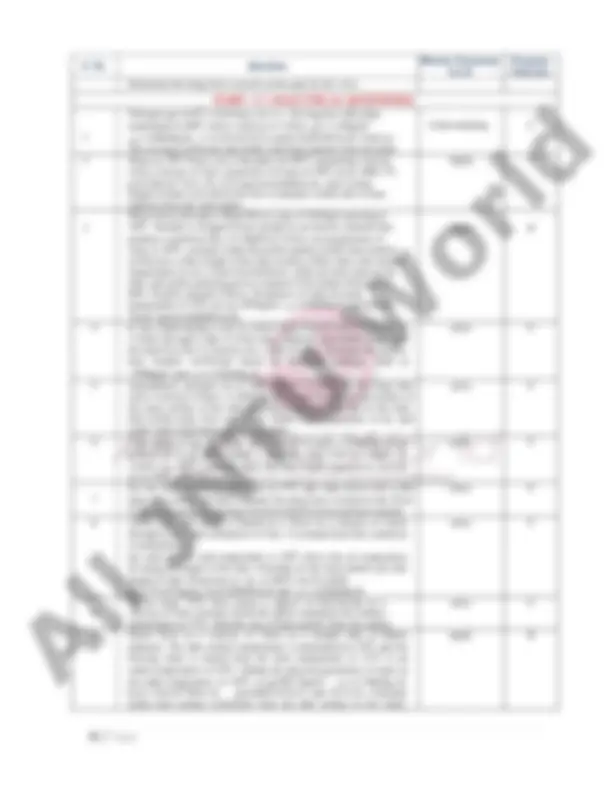
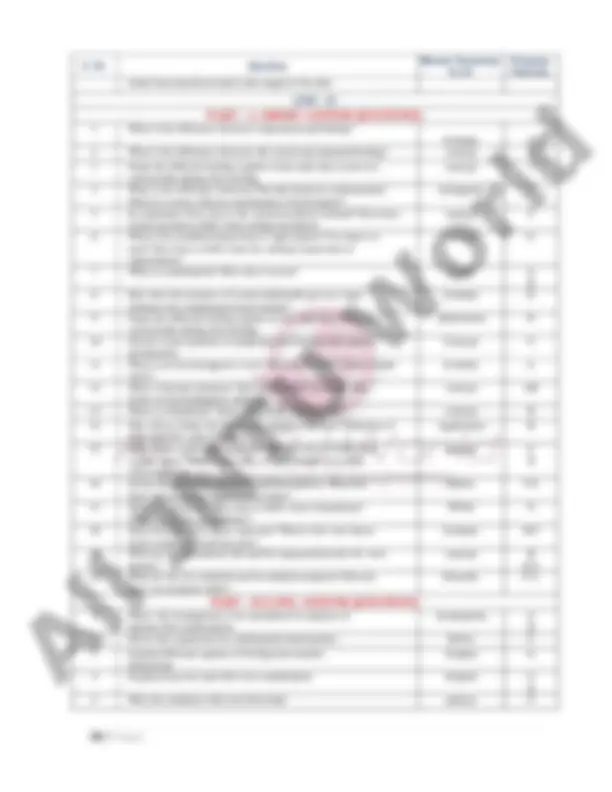
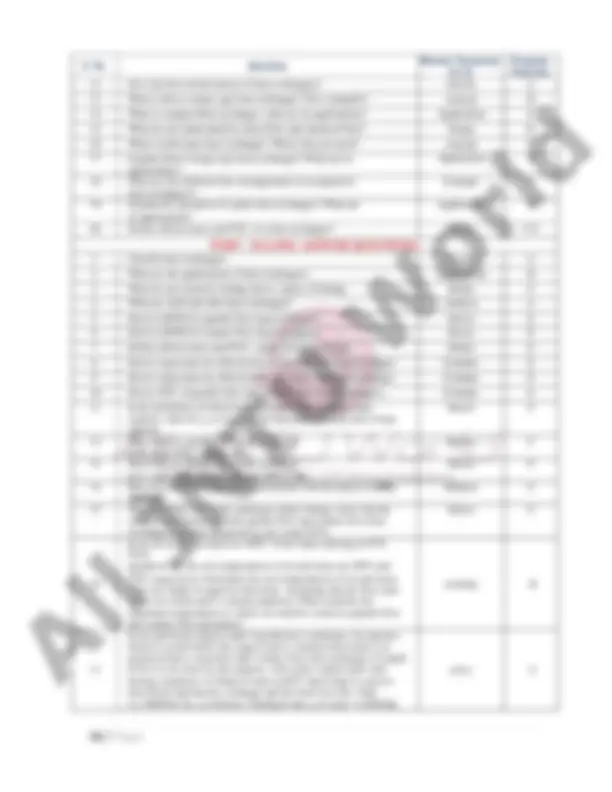
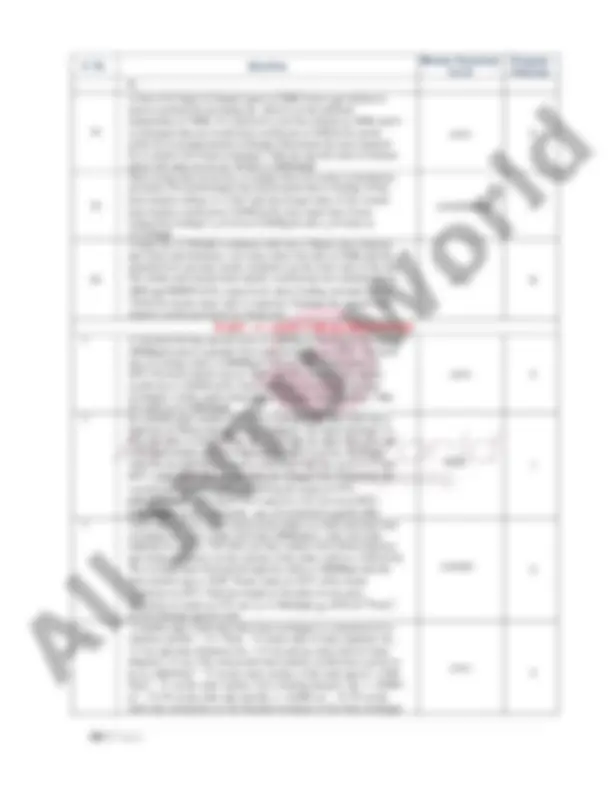
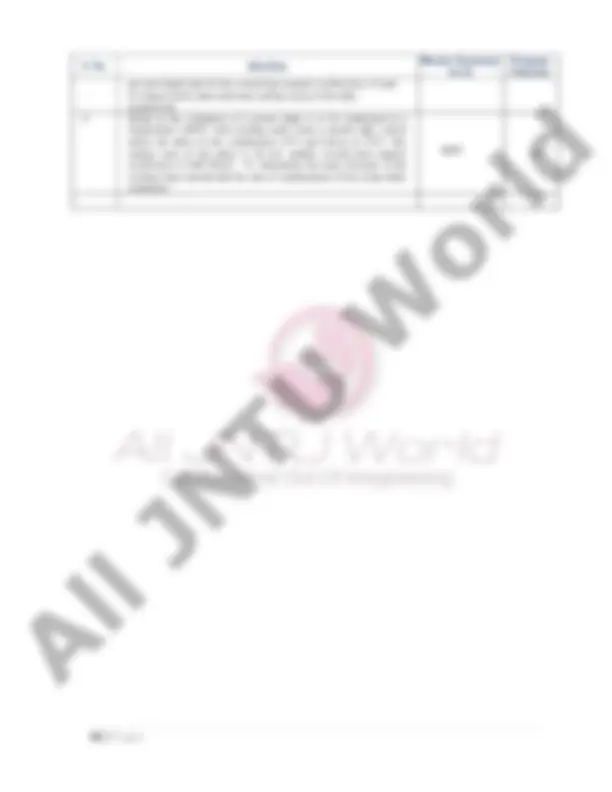


Study with the several resources on Docsity

Earn points by helping other students or get them with a premium plan


Prepare for your exams
Study with the several resources on Docsity

Earn points to download
Earn points by helping other students or get them with a premium plan
Community
Ask the community for help and clear up your study doubts
Discover the best universities in your country according to Docsity users
Free resources
Download our free guides on studying techniques, anxiety management strategies, and thesis advice from Docsity tutors
about heat transfer and its importance
Typology: Study notes
1 / 15

This page cannot be seen from the preview
Don't miss anything!










S. No Question Blooms Taxonomy Level Program Outcome UNIT – I
1 How does the science of heat transfer differ from the science of thermodynamics? Analyse A B 2 What is the driving force for (a) heat transfer, (b) electric current flow, and (c) fluid flow? Analyse A 3 What is heat flux? How is it related to the heat transfer rate? concept A B 4 What are the mechanisms of energy transfer to a closed system? How is heat transfer distinguished from the other forms of energy transfer?. concept A 5 How are heat, internal energy, and thermal energy related to each other? Evaluate B 6 Define thermal conductivity and explain its significance in heat transfer concept A 7 What are the mechanisms of heat transfer? How are they distinguished from each other? Evaluate B 8 How does heat conduction differ from convection?. Distinguish c All JNTU World
S. No Question Blooms Taxonomy Level Outcome 9 How does forced convection differ from natural convection? Distinguish F 10 Which is a better heat conductor, diamond or silver? Analyse F 11 What are the three modes of Heat Transfer? Explain their differences? Analyse A B 12 What does conduction refer to? State Fourier’s law of heat transfer? Analyse A 13 How does the temperature in a cylindrical wall vary? concept A B 14 Define thermal conductivity. How can it be determined experimentally? concept A 15 Why are metals good thermal conductors, while non metals are poor conductors of heat? Evaluate B 16 State Fourier’s law of heat conduction? why is the negative sign used? concept A 17 What is temperature gradient? Where it was used? Evaluate B 18 Explain the mechanism of heat conduction in glass, liquids and gasses? Distinguish c 19 How are Fourier’s law and Ohm’s law similar? Distinguish F 20 Explain the resistance concept to illustrate the analogy of heat flow and flow of electricity?
1 Distinguish between the basic laws of heat transfer with examples? analyze a 2 Discuss basic laws of 3 modes of heat transfer? Discuss a 3 Derive general conduction equation in Cartesian coordinates? Derive a 4 Derive conduction equation in cylindrical coordinates? Derive a 5 Derive conduction equation in spherical coordinate systems? Derive a 6 What are the applications of heat transfer? Application a 7 What are the different forms of heat transfer? Describe c 8 Describe different types of boundary conditions apply to heat conduction problem? Analyze B 9 Explain the concept of thermal diffusivity. Knowledge B 10 Explain the concept of convective mode of heat transfer Knowledge C (^11) Explain the concept of radiation mode of heat transfer Knowledge C 12 What are the physical mechanisms of heat conduction in solid, liquid and gases? Knowledge B 13 Does any of the energy of the sun reach the earth by conduction or convection? Explain. Knowledge C 14 Consider heat transfer through a windowless wall of a house in a winter day. Discuss the parameters that affect the rate of heat conduction Through the wall. Knowledge C 15 How the thermal conductivity of liquids and gases vary with temperature. Explain. Knowledge C 16 Consider a person standing in a breezy room at 20°C. Determine (^) Analysis B,C,D All JNTU World
S. No Question Blooms Taxonomy Level Outcome
A pipe 2 cm in diameter at 30 0 C is placed in (i) an air flow at 50^0 C with h=20 W/m^2 K and in (ii) water at 30 0 C with h=70W/m^2 K.Find the heat transfer rate per unit length of the pipe. Evaluate UNIT – II
1 How does transient heat transfer differ from steady heat transfer? How does one-dimensional heat transfer differ from two-dimensional heat transfer? Analyse a 2 From a heat transfer point of view, what is the difference between isotropic and anisotropic materials? Analyse e 3 What is heat generation in a solid? Give examples. concept e 4 What is a thermal symmetry boundary condition? Analyse e (^5) A container consists of two spherical layers, A and B, that are in perfect contact. If the radius of the interface is r0, express the boundary conditions at the interface. Evaluate f 6 Does heat generation in a solid violate the first law of thermodynamics, which states that energy cannot be created or destroyed? Explain Understand f 7 Is the thermal conductivity of a medium, in general, constant or does it varies with temperature? Understand g (^8) How is the combined heat transfer coefficient defined? What convenience does it offer in heat transfer calculations? Understand g 9 What is thermal contact resistance? How is it related to thermal contact conductance? concept e 10 What is the difference between the fin effectiveness and the fin efficiency Distinguish E 11 What is lumped system analysis? concept A 12 When is lumped system analysis it applicable? application A 13 In what medium is the lumped system analysis more likely to be applicable: in water or in air? Why? analyse A B 14 Obtain relations for the characteristic lengths of a large plane wall of thickness 2L, a very long cylinder of radius ro, and a sphere of radius ro. Analyse C 15 What is an infinitely long cylinder? concept AF 16 Define Biot number define AF 17 What is the physical significance of the Fourier number? Evaluate A F 18 Why are the transient temperature charts prepared using non dimensionalized quantities such as the Biot and Fourier numbers instead of the actual variables such as thermal conductivity and time?. Evaluate F 19 What is a semi-infinite medium? Give examples of solid bodies that can be treated as semi-infinite mediums for heat transfer purposes? Analyse f 20 Under what conditions can a plane wall be treated as a semi- infinite medium? analysis F
1 Derive one dimensional steady state conduction equation in case of slab derive e 2 Explain the following (i) Log mean area (ii)geometric mean area Explain g 3 What is critical thickness of insulation explain Define e 4 Derive the conduction in one-dimensional case for a Derive f All JNTU World
S. No Question Blooms Taxonomy Level Outcome cylinder 5 What are the assumptions for heat transfer analysis in case of fins analyze e 6 Derive the expression for heat transfer in fins in case of (i)Rectangular plate fin of uniform cross section (ii)insulated end. Derive e 7 Define fin and explain different types of fins. Estimate f 8 Explain briefly (i)Fin effectiveness (ii) Fin efficiency Explain e 9 Explain the heat transfer analysis in composite wall. evaluate e 10 Derive expression for critical thickness of insulation for a cylinder. Derive F 11 Under what conditions the systems are said to be lumped heat systems. Explain Understanding A 12 Explain the concept of lumped analysis. Explain A B 13 Derive the expression for heat transfer under transient mode derive G 14 Define Biot number and Fourier number .What is their importance in heat transfer. Explain. Define F 15 Explain how biot number help in transient conduction problem Application F 16 What are heisleir charts? Under what conditions heislier charts are used in heat transfer problems. Application F 17 Enumerate steps for solving long cylinders using heislier charts analysis A F 18 Enumerate steps for heat transfer analysis in slabs using heislier charts. analysis B F 19 A Thermocouple, the junction of which can be approximated as a 1mm diameter of a gas stream. The properties of the junction are ρ =8500kg/m^3 , c=320J/kg K and k=35W/m K. The heat transfer coefficient between the junction and the gas is 210W/m^2 K. Determine how long it will take for the thermocouple to read 99% of the initial temperature difference. Determine BF G 20 A Steel tube of length 20cm with internal and external diameters of 10 and 12cm is quenched from 500^0 C to 30^0 C in a large reservoir of water at 100 C it is less owing to a film of vapour being produced at the surface, and an effective mean value between 500^0 C and 100^0 C is 0.5kW/m^2. the density of steel is 7800kg/m^3 and the specific heat is 0.47kJ/kg K. neglecting internal thermal resistance of the steel tube, determine the quenching time Determine BF G
1 A Hollow heat cylinder with r 1 =30 mm and r 2 =50 mm , k=15W/mK is heated on the inner surface at a rate of 10 5 W/m^2 and dissipates heat by conduction from the outer surface to a fluid at 100 0 C with h=400 W/m^2 K. Find the temperature inside and outside surfaces of the cylinder. and also find rate of heat transfer through the wall solve f 2 A tube 2 cm. O.D maintained at uniform temperature of Ti is covered with insulation (k=0.20 W/m K) to reduce heat loss to the ambient air Tα with ha=15W/m^2 K. Find i) the critical thickness rc of insulation (ii)the ratio of heat loss from the tube with insulation to that without insulation, (a) if the thickness of insulation is equal to rc solve f (^3) Three 10cm dia rods A,B and C protrude from a steam bath at 100 0 C to a length of 25cm into an atmosphere at 20 0 C. The temperature at the other end are Ta=26.76^0 C, Tb=32^0 C and Tc=36.93^0 C. Find the thermal conductivities of the rod A, B and C, if h=23W/m^2 K solve g All JNTU World
S. No Question Blooms Taxonomy Level Outcome 2 What is the physical significance of the Nusselt number? How is it defined evaluate A G 3 Define incompressible flow and incompressible fluid. Must the flow of a compressible fluid necessarily be treated as compressible? concept B F 4 How does turbulent flow differ from laminar flow? For which flow is the heat transfer coefficient higher? evaluate B F 5 What is the physical significance of the Reynolds number? How is it defined for external flow over a plate of length L?. analyse F 6 What is turbulent thermal conductivity? What is it caused by? evaluate F 7 State Newtons law of cooling Is the acceleration of a fluid particle necessarily zero in steady flow? Explain. concept A C 8 What are the advantages of non dimensionalizing the convection equations? analyse F (^9) How is Reynolds analogy expressed? What is the value of it? What are its limitations? Evaluate F 10 What is drag? What causes it? Why do we usually try to minimize it? concept A D 11 What is natural convection? How does it differ from forced convection? What force causes natural convection currents? concept A F 12 In which mode of heat transfer is the convection heat transfer coefficient usually higher, natural convection or forced convection? Why evaluate A G 13 How does the Rayleigh number differ from the Grashof number concept B F 14 Consider laminar natural convection from a vertical hot plate. Will the heat flux be higher at the top or at the bottom of the plate? Why? evaluate B F 15 Show that the volume expansion coefficient of an ideal gas is 1/T, where T is the absolute temperature. analyse F 16 Why are finned surfaces frequently used in practice? Why are the finned surfaces referred to as heat sinks in the electronics industry? evaluate F 17 When is natural convection negligible and when is it not negligible in forced convection heat transfer? concept A C (^18) When neither natural nor forced convection is negligible, is it correct to calculate each independently and add them to determine the total convection heat transfer? analyse F (^19) Under what conditions does natural convection enhance forced convection, and under what conditions does it hurt forced convection? Evaluate F (^20) Why are heat sinks with closely packed fins not suitable for natural convection heat transfer, although they increase the heat transfer surface area more? concept A D
1 Differentiate between Newtonian and Non Newtonian fluids. Give examples Discuss A 2 What is boundary layer thickness what do you mean by laminar and turbulent boundary layers. Evaluate G 3 What is critical Reynolds number for flow over flat plate? Explain. Evaluate F 4 Define local and mean heat transfer coefficient. On what factors ‘h’ value depends on Analyse F 5 A metal plate 0.609^ m in height forms the vertical wall of an oven and is at a temperature of 171^0 C. Within the oven is air at a calculate F All JNTU World
S. No Question Blooms Taxonomy Level Outcome temperature of 93.4^0 C and the atmospheric pressure. Assuming that natural convention conditions hold near the plate, and that for this case Nu=0.548(Gr Pr)1/ find the mean heat transfer coefficient and the heat taken up by air per second per meter width. For air at 132.2^0 C, take k=33.2x10-^6 kW/m, μ=0.232x10-^4 kg/ms, cp=1.005kJ/kg K. Assume air as an ideal gas and R=0.287kJ/kg K. 6 A 0.15m outer diameter. steel pipe lies 2m vertically and 8m horizontally in a large room with an ambient temperature of 30^0 C. The pipe surface is at 2500 C and has an emissivity o f 0.60. Estimate The total rate of heat loss from the pipe to the atmosphere solve C 7 A nuclear reactor with its core constructed of parallel vertical plates 2.2n high and 1.45m wide has been designed on free convention heating of liquid bismuth. The maximum possible heat dissipation from both sides of each plate. For the convention coefficient the appropriate correlation is Nu=0.13(Gr.Pr)1/3^ where the properties evaluated at the mean film temperature of 650^0 C for bismuth are: ρ =10^4 kg/m^3 , cp=150.7J/kg K, k=13.02W/m K. solve C 8 State Buckingham pi theorem .What are the merits and demerits Describe A B D 9 What do you mean by VonKorman ‘s integral method. and derive drag force and heat transfer coefficient for flow over a flat plate Understanding G F 10 Explain Reynold’s analogy. Derive an expression for it. Understanding A F 11 What is physical significance of Grashoff number Derive β=1/T significance F 12 Explain the concept of Nusselt’s theory of laminar flow Explain F 13 Explain the conditions for which Dittus-Boelter equation can be used to determine heat transfer coefficient Explain C 14 What is Rayleigh number? Discuss the nature of flow with respect to it. Define F 15 What do you mean by hydrodynamic entry length? Define D 16 Give the steps to find heat transfer in natural convection. Analyse C E 17 Air at 1atm and 30^0 C is forced through a horizontal 30mm diameter 0.5m Long at an average velocity of 0.25m/s. The tube wall is maintained at 137^0 C. Calculate (a) the heat transfer coefficient and (b) percentage error if the calculation is made strictly on the basis of laminar forced convention Apply C 18 Engine oil at 60°C flows over the upper surface of a 5-m-long flat plate whose temperature is 20°C with a velocity of 2 m/s Determine the total drag force and the rate of heat transfer per unit width of the entire plate evaluate F 19 A square plate 0.4mx0.4m maintained at a uniform temperature of Tw=400K is suspended vertically in quiescent atmospheric air at 270 C. Determine (a)the boundary layer thickness at the trailing edge of the plate(i.e. at x=0.4m),(b)the average heat coefficient over the entire length by using theoretical analysis .Properties of air at 35^0 K are ν=2.075x10-^6 m^2 /s, Pr=0.697 and k= 0.03W/m K. solve C 20 A 2.2cm outer diameter pipe is to cross a river at a 30mwide section while being completely immersed in water The average flow velocity of water is 4 m/s and the water temperature is 15^0 C. All JNTU World^ apply^ B
S. No Question Blooms Taxonomy Level Outcome (b)the heat transferred and (c)the length of the tube. UNIT - IV
1 What is the difference between evaporation and boiling? Evaluate A 2 What is the difference between sub cooled and saturated boiling? concept B 3 Name the different boiling regimes in the order they occur in a vertical tube during flow boiling concept f 4 What is the difference between film and dropwise condensation? Which is a more effective mechanism of heat transfer? distinguish f (^5) In condensate flow, how is the wetted perimeter defined? How does wetted perimeter differ from ordinary perimeter concept F 6 What is the modified latent heat of vaporization? For what is it used? How does it differ from the ordinary latent heat of vaporization? concept G 7 What is condensation? How does it occur? Apply A B 8 How does the presence of a noncondensable gas in a vapor influence the condensation heat transfer? Evaluate D (^9) Name the different boiling regimes in the order they occur in a vertical tube during flow boiling phenomena D 10 Discuss some methods of enhancing pool boiling heat transfer permanently. Concept C 11 What is an electromagnetic wave? How does it differ from a sound wave?. Evaluate A 12 What is thermal radiation? How does it differ from the other forms of electromagnetic radiation?. concept AB 13 What is a blackbody? Does a blackbody actually exist? concept B 14 Why did we define the blackbody radiation function? What does it represent? For what is it used? Application B 15 What does a solid angle represent, and how does it differ from a plane angle? What is the value of a solid angle associated with a sphere? analysis C B 16 Define the properties emissivity and absorptivity. When are these two properties equal to each other? Define F E 17 What is a graybody? How does it differ from a blackbody? What is a diffuse gray surface? Define E 18 What does the view factor represent? When is the view factor from a surface to itself not zero? Evaluate B F 19 What are the summation rule and the superposition rule for view factors? concept B D F 20 What are the two methods used in radiation analysis? How do these two methods differ? Describe F A
1 What r the assumptions to be considered for analysis of laminar film condensation Assumptions A B 2 Derive the expression for condensation heat transfer. Derive F 3 Explain different regimes of boiling heat transfer phenomena Explain E 4 Explain drop wise and film wise condensation Explain A B 5 Why the condenser tubes are horizontal analyse A All JNTU World
S. No Question Blooms Taxonomy Level Outcome 6 What is nucleate boiling explain Explain F 7 Explain film boiling explain Explain F 8 Write the correlations for boiling heat transfer incase of nucleate bioling Enumerate F G 9 Differentiate between different types of condensers Differentiate B D 10 Write correlations for condensation heat transfer .. enumerate F 11 Explain what do you mean by absorptivity ,reflectivity and transmissivity analyse A B 12 Define Opaque body and black body Define A 13 Define momochromatic emissive power and total emissive power Define A 14 What are the basic laws of radiation. Analyse B C 15 What is shape factor obtain the expression for it Evaluate A 16 Derive expression for radiant energy between two small gray surfaces Evaluate A 17 Explain radiosity Evaluate B 18 Explain irradiation concept C 19 Write expression for monochromatic emissive power Expression G 20 Write expression for blackbody radiation. .. Expression G
1 Saturated steam at 54.5^0 C condenses on the outside surface of a 25.4mm outer diameter 3.66m long vertical tube maintained at a uniform temperature of 43.3^0 C. Because of the occurrence of ripples on the surface of the condensate film the actual heat transfer coefficient 20% higher than the obtained by Nusselt's equation. Determine the average condensation heat transfer coefficient over the entire length of the tube and the rate of condensate flow at the bottom of the tube. Check that the flow is laminar. The properties of condensate at 48.9^0 C are hfg=2372.4kJ/kg K, k=0.642W/m K, ρ =988.4kg/m^3 and μ =0.558x10-^3 kg/m s. solve A 2 Saturated steam at 110^0 C condenses on the outside of a bank of 64 horizontal tubes of 25mm outer diameter; 1m long arranged 8x square arrays. Calculate the rate of condensation if the tube surface is maintained at 100^0 C. The properties of saturated water at 105^0 C are ρ=654.7kg/m^3 , k=0.684W/m^2 K, μ =271x10-^6 Kg/mS and h fg=2243.7kJ/kg. solve G 3 A Vertical plate 300mm wide and 1.2m high is maintained at70^0 C and is exposed to saturated steam at 1atm pressure. Calculate the heat transfer coefficient and the total mass of steam condensed per hour. What would be the heat coefficient if the plate is inclined at 30^0 C to the vertical? solve G 4 Estimate the power required to boll water in a copper pan, 0.35m in diameter. The pan is maintained at 120^0 C by an electric heater. What is the evaporation rate? Estimate the critical heat flux solve G 5 A metal-clad heating element of 8mm diameter and emissivity 0.9 is horizontally immersed in a water bath. The surface temperature of the metal is 260^0 C under steady-state boiling conditions. Estimate the power dissipation per unit length of heater apply B 6 Water is to be boiled at atmospheric pressure in a mechanically polished stainless steel pan placed on top of a heating unit, The inner solve G All JNTU World
S. No Question Blooms Taxonomy Level Outcome 12 Give the three broad classes of heat exchangers? classify A 13 What is direct contact type heat exchanger? Give examples? concept B 14 What is compact Heat exchanger, what are its applications? Application C 15 What do you understand by mixed flow and unmixed flow? design D 16 What is multi pass heat exchanger? Where they are used? concept F (^17) Explain about storage type heat exchanger? What are its applications? Application B 18 What are the different flow arrangements in recuperative heat exchangers? Evaluate C 19 Explain the operation of a plate heat exchanger? What are its applications? Application B 20 Define effectiveness and NTU of a heat exchanger? Define F E
1 Classify heat exchangers Classify A 2 What are the applications of heat exchangers.. Applications B 3 What do you mean by fouling factor..causes of fouling Define C 4 What are shell and tube heat exchangers? Analyse A 5 Derive LMTD for parallel flow heat exchangers Derive E 6 Derive LMTD for counter flow heat exchangers Derive E 7 Define effectiveness and NTU ,;mmk of heat exchanger Define E 8 Derive expression for effectiveness of parallel flow heat exchanger Evaluate E 9 Derive expression for effectiveness of counter flow heat exchanger Evaluate E 10 Derive NTU of parallel flow and counter flow heat exchangers. .. Evaluate E 11 In the definition of effectiveness, explain why minimum heat capacity value (Cmin) is used for the maximum possible rate of heat transfer. Derive C 12 Show that for paraller flow heat exchanger ε=[1-exp(-NTU(1+R)]/[1+R] Derive C 13 Show that for paraller flow heat exchanger ε=[1-exp(-NTU(1-R)]/[ 1-R exp(-NTU(1-R] Derive C 14 How are exit fluid temperature determined with the help of ε-NTU method? Analyse A 15 When on of the two fluids undergoes phase change, show that the effectiveness values for both parallel flow and counter flow heat exchangers are eual and given by ε=1-exp(-NTU) Derive C 16 In an oil cooler, oil enters at 160^0 C. If the water entering at 35^0 C flows parallel to oil, the exit temperatures of oil and water are 90^0 C and 700 C respectively. Determine the exit temperatures of oil and water if the two fluids in opposite directions. Assuming that the flow rates of the two fluids and U 0 remain unaltered. What would be the minimum temperatures to which oil could be cooled in parallel flow and counter flow operations? creating B 17 In an open heart surgery under hypothermic conditions, the patient's blood is cooled before the surgery and re warmed afterwards. It is proposed that a concentric tube counter flow heat exchanger of length 0.5m is to be used for this purpose, with a thin-walled inner tube having a diameter of 55mm.If water at 60^0 C and 0.1kg/s is used to heat blood entering the exchanger and the heat flow rate. Take U 0 =500W/m^2 K, cp of blood=3.5kJ/kg K and cp of water 4.183kJ/kg solve C All JNTU World
S. No Question Blooms Taxonomy Level Outcome K. 18 A flow of 0.1kg/s of exhaust gases at 700K from a gas turbine is used to preheat the incoming air, which is at the ambient temperature of 300K. It is desired to cool the exhaust to 400K and it is estimated that an overall heat coefficient of 30W/m^2 K can be achieved in an appropriate exchanger.Determine the area required for a counter flow heat exchanger. Take the specific heat of exhaust gasses the same as for air, Which is 1000J/kgK. solve C 19 After a long time in service, a counter flow oil cooler is checked to ascertain if its performance has deteriorated due to fouling. In the heat transfer surface is 3.33m^2 and the design value of the overall heat transfer coefficient is 930W/m^2 K, how much has it been reduced by fouling? cp of oil as 2330J/kg K and cp of water as 4174J/kgK. remembering C 20 A brass (k=111W/mK) condenser tube has a 30mm outer diameter and 2mm wall thickness. sea water enters the tube at 290K and the saturated low pressure steam condenses on the outer side of the tube. The inside and outside heat transfer coefficients are estimated to be 4000 and 8000W/m^2 K, respectively and a fouling resistance of 10- (^4) (W/m (^2) K) on the water side is expected. Estimate the overall heat transfer coefficient based on inside area. apply B
1 A chemical having specific heat of 3.3kJ/kg K flowing at the rate of 20000kg/h enters a parallel flow heat exchanger at 120^0 C. The flow rate of cooling water is 50000kg/h with an inlet temperature of 200 C.The heat transfer area is 10m^2 and the overall heat transfer coefficient is 1050W/m^2 K. Find (i)the effectiveness of the heat exchanger, (ii)the outlet temperatures of water and chemical. Take for water cp=4.186kJ/kgK solve 6 2 In a double-pipe counter flow heat exchanger the inner tube has a diameter of 20mm and very little thickness. The inner diameter of the outer tube is 30mm.Water flows through the inner tube at a rate of 0.5kg/s and the oil flows through the shell at a rate of 0.8kg/s. Take the average temperatures of the water and the oil as 47^0 C and 800 C respectively and assume fully developed flow. Determine the overall heat transfer coefficient. Given:for water at 47^0 C, ρ=0.637W/mK , ν=0.59x10-^6 m^2 /s and Pr=3.79. For oil at 80^0 C, ρ=852kg/m^3 , k=0.138W/m K , nu =37.5x10-^6 m^2 /s and Pr=490. Apply (^7) 3 The condenser of a large steam power plant is a shell-and-tube heat exchanger having a single shell and 30000tubes, with each tube making two passes. The tubes are thin-walled with 25mm diameter and steam condenses on the outside of the tubes with h 0 =11kW/m^2 K. The cooling water flowing through the tubes is 30000kg/s and the heat transfer rate is 2GW. Water enters at 20^0 C while steam condenses at 50^0 C. Find the length of the tubes in one pass. Properties of water at 27^0 C are cp=4.18kJ/kgK, μ =855x10-^6 Ns/m^2 , k=0.613W/mK and Pr=5. evaluate (^8) 4 A double-pipe (shell-and-tube) heat exchanger is constructed of a stainless steel(k = 15.1 W/m · °C) inner tube of inner diameter Di _ 1.5 cm and outer diameter Do =1.9 cm and an outer shell of inner diameter 3.2 cm. The convection heat transfer coefficient is given to be hi = 800 W/m^2 · °C on the inner surface of the tube and ho = 1200 W/m^2 · °C on the outer surface. For a fouling factorof Rf , i = 0. m^2 · °C/ W on the tube side and Rf , o = 0.0001 m^2 · °C/ W on the shell side, determine ( a ) the thermal resistance of the heat exchanger solve (^9) All JNTU World